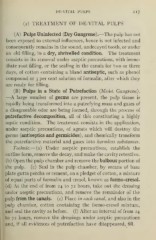Page 249 - My FlipBook
P. 249
DE-VITAL PULPS 217
(2) TREATMENT OF DE-VITAL PULPS
(A) Pulps Uninfected (Dry Gangrene).—The pulp has not
been exposed to external influences, hence is not infected and
consequently remains in the sound, undecayed tooth, or under
an old filling, in a dry, shrivelled condition. The treatment
consists in its removal under aseptic precautions, with imme-
diate root filling, or the sealing in the canals for two or three
days, of cotton containing a bland antiseptic, such as phenol
compound or per cent solution of formalin, after which they
5
are ready for filling.
(B) Pulps in a State of Putrefaction (Moist Gangrene).
—A large number of germs are present, the pulp tissue is
rapidly being transformed into a putrefying mass and gases of
a disagreeable odor are being formed, through the process of
putrefactive decomposition, all of this constituting a highly
septic condition. The treatment consists in the application,
under aseptic precautions, of agents which will destroy the
germs (antiseptics and germicides), and chemically transform
the putrefactive material and gases into harmless substances.
Technic.— (a) Under aseptic precautions, establish the
outline form, remove the decay, and make the cavity retentive.
(b) Open the pulp chamber and remove the bulbous portion of
the pulp, (c) Seal in the pulp chamber, by means of base
plate gutta percha or cement, on a pledget of cotton, a mixture
of equal parts of formalin and cresol, known as formo-cresol.
(d) At the end of from 24 to 72 hours, take out the dressing
under aseptic precautions, and remove the remainder of the
pulp from the canals, (e) Place in each canal, and also in the
pulp chamber, cotton containing the formo-cresol mixture,
and seal the cavity as before, (f) After an interval of from 24
to 72 hours, remove the dressings under aseptic precautions
and, if all evidences of putrefaction have disappeared, fill.


